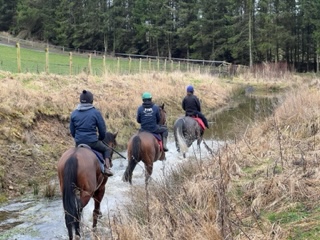Impact of Climate Change on Horse Racing
The impact of climate change on horse racing in the UK and Ireland is giving rise to concerns regarding the future viability of the industry.
 Grand National Racegoers
Grand National RacegoersA new study by the World Weather Attribution group warns that every five years, the UK will experience extreme rainfall that is 20 per cent wetter than we are used to.
The increasing wet weather and extreme rainfall events expected as part of climate change could significantly impact the UK and Irish horse racing industries in several ways.
The wet weather we experience in the UK comes mainly from the West over the Atlantic, as it picks up water vapour from hotter climates.
Global warming increases the water holding capacity of the atmosphere and when this warmer, water-laden air reaches the high ground of the South West, the Welsh hills, the Pennines and the mountains of Scotland it results in heavy rain storms.
Horse race meetings have been increasingly impacted by extreme weather resulting in abandoned meetings especially the National Hunt events during the winter months. A concerning picture begins to emerge of the potential impacts for the future of the UK and Irish horse racing industry.
 Fantasy Waterlogged Racecourse
Fantasy Waterlogged RacecourseImpact of Climate Change on Horse Racing
1. Track Conditions and Race Scheduling: Increased rainfall can lead to waterlogged tracks making racing conditions unsafe and unpredictable. This might cause frequent race cancellations or delays, disrupting the racing calendar significantly.
For example
- In February 2023, heavy snowfall forced the cancellation of race meets at Doncaster and Thurles in the UK.
- Similarly, a Bangor race meeting was abandoned due to a waterlogged track caused by rain, sleet, and snow.
Frequent cancellations disrupt the travel and logistical plans of trainers, jockeys, and owners who might have planned their schedules around specific race dates.
Waterlogged tracks can also require more maintenance to ensure safety standards, potentially increasing operational costs for racecourses.
 Water Walkway
Water Walkway2. Training Disruptions: Consistent and extreme wet weather can interfere with the training schedules of horses. Training tracks may become unsuitable for use, which could hinder the preparation and fitness levels of horses.
- Trainers may have to limit the intensity or duration of workouts on damp tracks. Horses need firm footing to push themselves to their full potential during training, and softer tracks don't allow for such strenuous exercise.
- Missed Workouts: In severe cases, trainers might have to cancel workouts entirely if the tracks are deemed too dangerous. This can lead to horses losing crucial training time and potentially impacting their fitness level for upcoming races.
3. Horse Health and Welfare: Prolonged exposure to damp and muddy conditions can lead to various health issues in horses, including hoof problems like thrush, and other skin disorders like rain scald.
Hoof Problems:
- Thrush: This bacterial infection thrives in moist environments. Standing in mud for extended periods creates the perfect breeding ground for bacteria that cause thrush. Symptoms include a foul odor, black discharge from the hooves, and discomfort for the horse.
- Mud Fever: Similar to thrush, mud fever is a bacterial infection affecting the legs. It causes inflammation, scabbing, and hair loss on the pasterns (lower legs) due to constant exposure to mud and moisture.
- Softened Hooves: Prolonged wetness can soften the hoof wall, making it more prone to cracks, splits, and injuries.
Skin Disorders:
- Rain Rot (Rain Scald): This fungal infection affects the horse's back, hindquarters, and other areas where water tends to pool. It causes itching, hair loss, and crusty lesions on the skin. Horses with weakened immune systems or those without proper shelter are more susceptible.
- Skin Irritations: Constant exposure to mud and moisture can irritate a horse's sensitive skin, leading to itching, rubbing, and potential open wounds.
- Arthritis: Damp, cold weather can exacerbate joint pain and stiffness in horses with arthritis.
Increased Costs for Horse Care:
- Veterinary Care: Treating hoof infections, skin conditions, and managing arthritis can require additional veterinary care, including medications, topical treatments, and potentially bandaging.
- Preventative Measures: Regular hoof cleaning, applying barrier creams to legs and pasterns, and providing proper drainage in stalls can help prevent some wet-weather health issues but come at an additional cost.
- Improved Facilities: Providing adequate shelter for horses during wet weather can be expensive. Ideally, horses should have access to dry paddocks or run-in sheds to escape the rain and mud.
 Three two year olds having a break in the paddock
Three two year olds having a break in the paddock4. Breeding and Keeping Horses: Increased dampness and colder conditions could affect breeding cycles and the general upkeep of horses. More robust shelter and housing designs might be required to protect horses from the elements, which could lead to increased spending in these areas.
Impact on Mare Fertility:
- Daylight Hours: Horses are seasonal breeders, with shorter daylight hours typically triggering estrus (heat cycles) in mares. However, if wet weather persists and reduces overall daylight exposure, it could delay or disrupt their natural breeding cycles.
- Temperature Fluctuations: Extreme temperature variations, especially sudden cold snaps, can also negatively affect a mare's ability to conceive.
Examples:
- A study by the University of Edinburgh found a correlation between increased rainfall and delayed foal heat cycles in UK breeding programs.
Foal Development and Care:
- Weak Immune Systems: Colder and wetter conditions can make foals more susceptible to respiratory illnesses during their crucial first few months.
Upkeep Challenges and Increased Costs:
- Mud Management: Increased rainfall leads to muddy paddocks and turnout areas. This can be difficult to manage, requiring more frequent cleaning and bedding changes to prevent hoof problems and skin conditions.
- Shelter Requirements: Horses in the UK typically rely on natural grazing for a significant portion of the year. However, with more frequent wet weather, they may need access to covered shelters or well-drained paddocks for extended periods. This might necessitate building new shelters or improving existing ones.
Examples:
- In recent years, several UK racing yards have reported increased spending on additional bedding and improvements to drainage systems in their paddocks to cope with wetter weather conditions.
Financial Burden:
- Small breeders and horse owners may struggle to afford the additional costs associated with improved shelter, bedding, and potentially increased veterinary care due to weather-related health issues.
Potential Solutions:
- Breeding Management: Adapting breeding programs to account for potential weather disruptions by using artificial insemination or adjusting breeding schedules might be necessary.
- Shelter Design: Investing in well-ventilated shelters with proper drainage and mud-free areas can help provide horses with better protection from the elements.
By adapting breeding practices and making adjustments to horse housing, the UK's horse industry can find ways to mitigate the challenges posed by a changing climate.
5. Insurance Costs: As the risk of event cancellations and horse injuries increases, it is likely that insurance costs associated with racing events and horse ownership will rise. This could strain financial resources across the industry, from racecourses to horse owners.
Increased Risk, Increased Premiums:
- Event Cancellations: As discussed earlier, extreme weather events can lead to frequent race cancellations. Insurance companies will likely factor this increased risk into their calculations, potentially leading to higher premiums for event cancellation coverage for racecourses.
- Horse Injuries: Wet weather conditions can contribute to more frequent horse injuries due to factors like track conditions and limitations on training routines. Insurance companies might raise premiums for equine mortality, veterinary expenses, and loss of earnings due to injury if claim rates rise.
Examples:
- The British Horseracing Authority (BHA) reported a rise in the number of weather-related race cancellations in 2023 compared to the previous five-year average. This trend could prompt insurance companies to adjust their pricing for event cancellation coverage for UK racecourses.
- In 2022, several UK equine insurance providers reported an increase in claims related to hoof infections and other wet-weather health issues in horses. This could be a precursor to broader cost increases across the equine insurance market.
Financial Strain Across the Industry:
- Racecourses: Higher premiums for event cancellation coverage could reduce profit margins for racecourses, impacting their ability to invest in infrastructure upgrades or maintain prize money levels.
- Horse Owners and Trainers: Increased costs for horse insurance, combined with potential rises in veterinary care and facility maintenance, could strain the budgets of owners and trainers, particularly smaller operations. This might force some out of the industry or limit their participation in racing events.
Potential Solutions:
- Risk Mitigation Strategies: Racecourses could explore alternative insurance options or implement risk mitigation strategies like scheduling backup dates for races to minimize the impact of cancellations.
- Industry Collaboration: Collaborative efforts between the BHA, insurance companies, and industry stakeholders might help develop risk-sharing programs or insurance products tailored to the specific challenges posed by climate change.
By acknowledging the potential impact of climate change on insurance costs and taking proactive steps, the UK horse industry can work towards a more sustainable future for both equine athletes and the businesses that rely on them.
6. Adaptation Measures: The industry might need to invest in better drainage systems for tracks, create more indoor training facilities, and develop strategies to deal with frequent disruptions. These adaptation measures would require significant investment and ongoing maintenance costs.
 Ludlow Racecourse
Ludlow Racecourse7. Spectator Attendance and Revenue: Frequent cancellations or less predictable scheduling due to extreme weather could reduce spectator attendance and impact betting revenues critically. This would affect the economic health of the racing industry, which significantly relies on these revenue streams.
Dampening the Experience: How Extreme Weather Impacts Attendance and Revenue in UK Horse Racing
Reduced Attendance:
- Unreliable Scheduling: Frequent cancellations and postponements due to extreme weather create an unreliable racing calendar. This makes it difficult for fans to plan their attendance, leading to a potential decrease in overall spectator numbers.
- Unpleasant Conditions: Even if races proceed during bad weather, spectators might be less willing to attend due to the discomfort of rain, wind, or cold temperatures. This could be especially true for families with young children or elderly patrons.
Examples:
- A study by the University of York found a correlation between rainy race days and lower attendance figures at UK racecourses.
- In 2023, several race meetings in the UK experienced significantly lower attendance than usual due to heavy rain and strong winds, impacting on-site ticket sales and merchandise revenue.
Impact on Betting Revenue:
- Reduced On-Course Betting: Lower attendance translates to a drop in on-course betting revenue, a significant income stream for racecourses.
- Potential Shift to Online Betting: While online betting might see an increase as fans stay home due to bad weather, this revenue is often shared with different platforms, reducing the direct financial benefit for racecourses.
 Chester Racecourse Punters
Chester Racecourse PuntersEconomic impact of climate change on horse racing:
- Prize Money: Declining revenue from attendance and betting can negatively impact prize money offered for races. This could make racing less attractive to top trainers and horses, potentially affecting the overall quality of competition.
- Job Losses: Racecourses and related businesses might be forced to cut back on staff or reduce operational hours due to lower income, impacting employment opportunities within the industry.
Examples:
- The Racecourse Association, the governing body for UK racecourses, reported a decrease in overall revenue in 2023, partly attributed to weather-related disruptions and lower attendance figures.
Potential Solutions:
- Improved Facilities: Investing in covered grandstands, sheltered walkways, and comfortable viewing areas can encourage attendance even during bad weather.
- Enhanced Digital Engagement: Developing user-friendly online platforms and mobile apps can enhance the racecourse experience for those unable to attend in person, potentially increasing online betting revenue.
- Flexible Scheduling: Exploring alternative scheduling options, like doubleheaders or twilight races, could provide more flexibility to accommodate weather disruptions and cater to a wider audience.
By acknowledging the challenges posed by extreme weather and implementing innovative solutions, the UK horse racing industry can work towards a more resilient business model that protects its economic well-being.
8. Regulatory and Policy Changes: There may be a requirement for new regulations and policies to manage the increasing impacts of climate change on the racing industry. This might include stricter standards for track maintenance, animal welfare, and event contingency planning.
Adapting to the Weather: Potential Regulatory Changes in UK Horse Racing
Focus on Animal Welfare:
- Track Safety Standards: Regulatory bodies like the British Horseracing Authority (BHA) might introduce stricter guidelines for track maintenance in wet weather. This could involve mandatory inspections, limitations on racing on overly saturated surfaces, and investments in improved drainage systems for racecourses.
- Extreme Heat Protocols: With rising temperatures, regulations regarding horse transportation and racing during hot weather might become more stringent. This could include mandatory cooling protocols, restrictions on race times, and the use of specially equipped vehicles for horse transport.
Examples:
- In 2023, the BHA issued a consultation paper outlining potential changes to racecourse licensing regulations, with a focus on improved track maintenance and drainage to ensure safety during wet weather.
Contingency Planning and Risk Management:
- Weather Monitoring and Postponement Guidelines: New regulations could require racecourses to implement stricter weather monitoring procedures and establish clearer guidelines for race postponement or cancellation based on specific weather forecasts.
- Insurance Incentives: The BHA might work with insurance companies to develop incentive programs for racecourses that implement robust risk management plans for weather disruptions.
Examples:
- The Racecourse Association, along with other industry stakeholders, is currently exploring the possibility of a centralized weather forecasting and risk assessment system for UK racecourses to improve preparedness for extreme weather events.
Challenges and Considerations:
- Financial Impact: Implementing stricter regulations and new protocols might require significant financial investments from racecourses for infrastructure upgrades and improved monitoring systems.
- Balancing Safety and Economics: Finding the right balance between stricter regulations to ensure animal welfare and the economic viability of the racing industry will be crucial.
Collaborative Approach:
- Open communication and collaboration between the BHA, racecourses, trainers, owners, and other stakeholders will be essential in developing and implementing effective regulations that address climate change impacts while considering the overall health of the industry.
By embracing a proactive approach to regulatory changes, the UK horse racing industry can ensure the safety and well-being of horses while adapting to the challenges posed by a changing climate.
Conclusion
The increasing wet weather forecasted for the UK and Ireland poses significant challenges for the horse racing industry. Adapting to these changes will require substantial investment, innovative solutions, and support from both the government and the broader community.
By proactively addressing these issues, the industry can mitigate some of the negative impacts and continue to thrive in the face of a changing climate.
Your second block of text...

You Might Like These
Kentucky Derby Odds: Will there be a hometown favorite?
Preakness Stakes Odds: Will the champions face fresh challengers?
Belmont Stakes Odds: At 1½ miles, stamina becomes the great equalizer as longshots can threaten.
Breeders' Cup Odds: International talent collides with American speed, reshuffling expectations across the board.
Dubai World Cup Odds: Under desert lights, can a Japanese sensation prevail against the world's elite.
Pegasus Cup Odds: Retirement beckons for champions seeking one final payday at America's richest race.
Bet on Horses: Every wager tells a story of hope against mathematical probability.
Kentucky Derby Betting: Beneath fancy hats and mint juleps, fortunes change hands with each thundering hoof.
Preakness Stakes Betting: The middle jewel rewards those who recognize when Derby form holds true.
Belmont Stakes Betting: Distance separates champions from pretenders when the final furlong tests them all.
Breeders Cup Betting: Global racing converges for two days where value hides in plain sight.

Returns Policy: Once a customer has agreed to pay for a product or service no returns will be permitted or payments returned.
All PayPal transactions are subject to the PayPal Privacy Policy
Privacy Policy: Personal details provided to this site by an individual may be shared with third parties unless requested otherwise.
Above policies updated 15 March 2018



